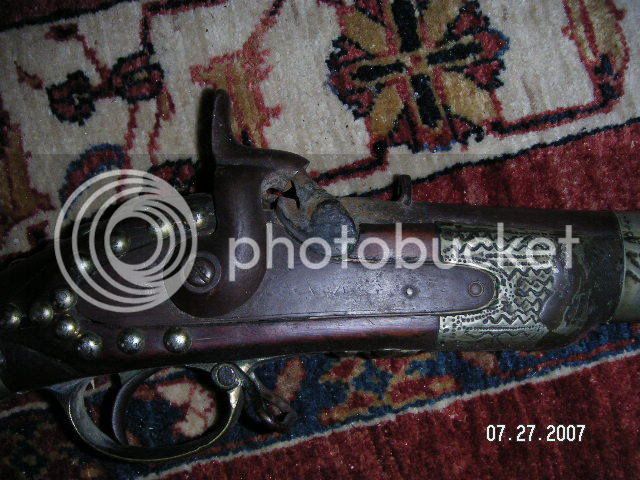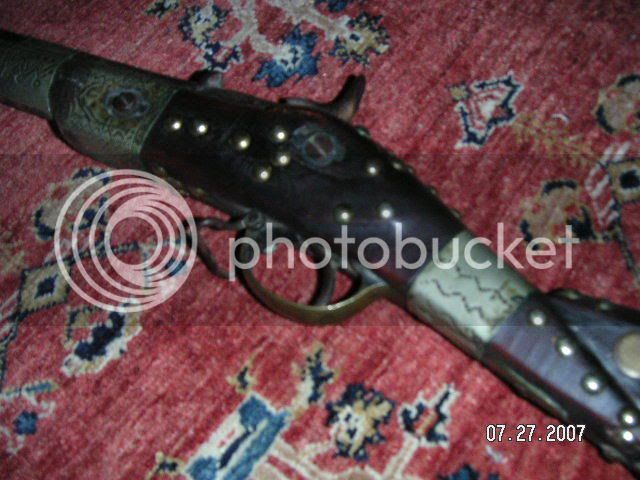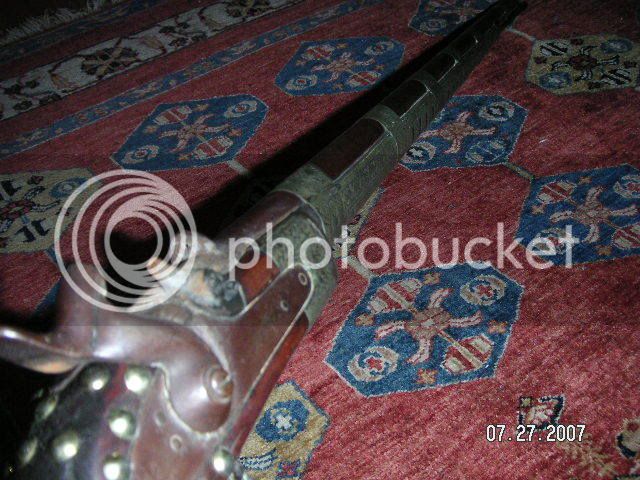Hi,
I previously posted a few pics of an 18th (?) century Indian torador that belonged to my great aunt in the "matchlock" sub-forum.
They were a GREAT help in identifying the piece (given what little info was available) and I'm hoping you'll be able to do the same...
First, I *think* this is a percussion rifle, apologies if it's a flintlock. If so, mods please move.
Interestingly enough, while I was scouring the web for info on the abovementioned matchlock, I actually stumbled across what I believe to be this model rifle.
Unfortunately, I neglected to bookmark the page. :cursing:
What I do recall is that this piece is British, and based on the silver scrollwork/engraving, it's probably also a rifle that ended up in Indian hands.
Am I on the right track?
There's one marking that I can make out... a faint , calligraphy-esque stamp on the action that reads either "1806" or '1836".
Surprisingly (to me), the hammer spring is strong and it locks up securely in both the half and full-cock positions.
Can anyone tell me what model rifle this is? My recollection is that it's not particularly uncommon. Does the scrollwork (which I assume was done after the rifle was built) also appear to be of Indian origin?
Finally, any DIY restoration tips? And by that I mean mild, MILD restoration... basically just keeping it in it's current condition. I don't plan to spray it w/ a Brownell's bake-on finish or anything like that!
Thanks for your help! Any questions or further pic requests, feel free to ask!
-David




I previously posted a few pics of an 18th (?) century Indian torador that belonged to my great aunt in the "matchlock" sub-forum.
They were a GREAT help in identifying the piece (given what little info was available) and I'm hoping you'll be able to do the same...
First, I *think* this is a percussion rifle, apologies if it's a flintlock. If so, mods please move.
Interestingly enough, while I was scouring the web for info on the abovementioned matchlock, I actually stumbled across what I believe to be this model rifle.
Unfortunately, I neglected to bookmark the page. :cursing:
What I do recall is that this piece is British, and based on the silver scrollwork/engraving, it's probably also a rifle that ended up in Indian hands.
Am I on the right track?
There's one marking that I can make out... a faint , calligraphy-esque stamp on the action that reads either "1806" or '1836".
Surprisingly (to me), the hammer spring is strong and it locks up securely in both the half and full-cock positions.
Can anyone tell me what model rifle this is? My recollection is that it's not particularly uncommon. Does the scrollwork (which I assume was done after the rifle was built) also appear to be of Indian origin?
Finally, any DIY restoration tips? And by that I mean mild, MILD restoration... basically just keeping it in it's current condition. I don't plan to spray it w/ a Brownell's bake-on finish or anything like that!
Thanks for your help! Any questions or further pic requests, feel free to ask!
-David








